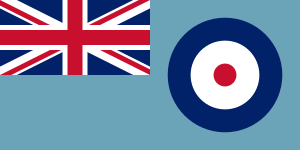Air Defence of Great Britain
The Air Defence of Great Britain (ADGB) was a RAF command comprising substantial army and RAF elements responsible for the air defence of the British Isles. It lasted from 1925, following recommendations that the RAF take control of homeland air defence, until 1936 when it became RAF Fighter Command.
| Air Defence of Great Britain | |
|---|---|
| Active | 1925–1936 |
| Country | |
| Branch | |
| Type | Command |
| Role | Homeland Air Defence |
| Garrison/HQ | Air Ministry, London (1925–1926) Hillingdon House, Uxbridge (1926–1936) |
History
The ADGB was created as a command in 1925 as a result of the 1923 recommendation of the Steel-Bartholomew Committee[1], including their recommendation to transfer responsibility for home air defence from the War Office to the Air Ministry. It main initial elements were:
- The RAF's Metropolitan Air Force, initially comprising 25 squadrons (9 fighter), soon expanding to 52 squadrons (17 fighter).
- 264 heavy AA guns (Royal Artillery) and 672 searchlights (Royal Engineers).
- The newly formed part-time volunteer Observer Corps.
ADGB was organised into three defensive zones:
- Inner Artillery Zone (IAZ), over London.
- Air Fighter Zone (AFZ), divided into two areas controlling regular squadrons, the Wessex Bombing Area and the Fighting Area.
- Outer Artillery Zone (OAZ), a narrow belt along the coast from Suffolk to Sussex.[2][3]
In 1936, ADGB was abolished as a command, with the Bombing Area becoming Bomber Command and the Fighting Area becoming Fighter Command and remaining responsible for the ADGB function.[4][5][6] The OAZ was abolished and the AFZ expanded. The guns from the OAZ were used for port and base defence and were added to the London defences. However, the changing threat meant that AA defences were needed for many more potential targets in the British Isles, notably industries important for war production. The AA component became 1st Anti-Aircraft Division, and in 1937, 2nd Anti-Aircraft Division was formed to defend the Midlands, with Anti-Aircraft Command created to replace the previous Army arrangements.[7]
In 1937, light AA guns were added, the RAF's view that small-calibre artillery were unsuitable having been finally overturned. In 1940, searchlights were transferred from the Royal Engineers to the Royal Artillery. Unrotated Projectile (rocket) batteries were deployed at the beginning of the war. At its peak from 1941–42, AA Command comprised I, II and III Anti-Aircraft Corps with twelve AA divisions, comprising several hundred regiments. GOC-in-C AA Command for most of the war was General Sir Frederick Pile, the equal in rank of his 'superior' AOC-in-C Fighter Command.[8]
ADGB was resurrected as a formal command in 1943 for the rump of Fighter Command defending the United Kingdom after the formation of the RAF Second Tactical Air Force in 1943 and AA Command.[9] It was Fighter Command in all but name, and this was finally reflected in 1944 with a return to the previous name.[10]
Air Officers Commanding-in-Chief 1925–1936
Air Officers Commanding-in-Chief included:[11]
| From | To | Name |
|---|---|---|
| 1 January 1925 | 26 May 1928 | Air Vice Marshal Sir John Salmond |
| 26 May 1928 | 1 January 1929 | Air Vice Marshal F R Scarlett (temporary appointment) |
| 1 January 1929 | 5 September 1931 | Air Marshal Sir Edward Ellington |
| 5 September 1931 | 17 January 1933 | Air Marshal Sir Geoffrey Salmond |
| 17 January 1933 | 1 August 1935 | Air Marshal Sir Robert Brooke-Popham |
| 1 August 1935 | 13 July 1936 | Air Marshal Sir John Steel |
Notes
- Air Commodore J. M. Steel of the Air Ministry and with Colonel W. H. Bartholomew of the War Office
- Routledge 1994, p. 41.
- "p. 62" A Short History of the Royal Air Force, Chapter 2, The Inter War Years, 1919–1939 Archived 12 October 2011 at the Wayback Machine
- Routledge 1994, pp. 44–46.
- "p. 87" A Short History of the Royal Air Force, Chapter 2, The Inter War Years, 1919–1939 Archived 12 October 2011 at the Wayback Machine
- "British Military Aviation in 1936" RAF Museum Archived 6 December 2010 at the Wayback Machine
- Routledge 1994, pp. 58–61
- Routledge 1994, pp. 64–67.
- "British Military Aviation in 1943 – Part 4" RAF Museum Archived 13 February 2011 at the Wayback Machine
- "British Military Aviation in 1944 – Part 5" RAF Museum Archived 13 February 2011 at the Wayback Machine
- "Air of Authority – A History of RAF Organisation – RAF Commands formed between 1920–1935". Archived from the original on 11 January 2011. Retrieved 23 January 2011.
References
- Delve, Ken. The Source Book of the RAF. Shrewsbury, Shropshire, UK: Airlife Publishing Ltd., 1994. ISBN 1-85310-451-5.
- Routledge, Brigadier N. W. (1994). A History of the Royal Regiment of Artillery–Anti-Aircraft Artillery, 1914–55. London: Brassey's. ISBN 1-85753-099-3.
